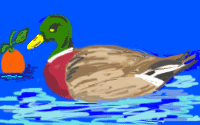
Pappardelle all'anatra
Tuscany
Preparation - Difficult
Serves 4
Pappardelle al'anatra is associated with Arezzo, capital of the easternmost province of Tuscany. An ancient Etruscan town dominating the high mountain valleys that surround it, Arezzo represents the sober side of the Tuscan character, old-fashioned, conservative, practical, close-mouthed, but with a rich culinary tradition. The sauce, which actually benefits from being prepared a day ahead and refrigerated until you are ready to use it, is rich and gamy, even when made with duck instead of hare. Traditional cooks add an even boskier flavor with about ½ ounce dried porcini mushrooms soaked in warm water until they soften. The water is strained through a sieve directly into the sauce, while the softened mushrooms are rinsed to rid them of any grit or sand, then coarsely chopped and added to the sauce with the tomatoes.
In the recipe, I've described a process used by restaurant chefs, who cook the pasta until about two-thirds done, then stir it into the sauce, adding a little of the pasta water, to finish cooking, so that the pasta itself absorbs flavors from the sauce. If you prefer a more traditional, less complicated cooking method, simply cook the pasta fully, drain it, and toss with half the sauce, then serve with the remaining sauce piled on top. Pappardelle are rather wide strips of pasta with ruffled edges (sometimes with a ruffled edge on one side only). If you can't find them, use any wide ribbon pasta.
As with other recipes, if pancetta is not available, substitute blanched slab bacon, and if the duck you buy comes without liver, use a couple of chicken livers in its place.
1 duck, weighing about 2 1/2 pounds, with its liver
1 stalk celery, chopped
2 small carrots, scraped and chopped
1 medium onion, chopped
4 large fresh sage leaves, coarsely chopped
2 oz diced pancetta (about 1/4 cup)
1 T extra virgin olive oil
1 1/2 cups dry white wine
1 (28-ounce) can tomatoes, or 2 cups peeled, seeded, and diced sweet, ripe, fresh tomatoes
1/3 cup finely chopped flat-leaf parsley
1/2 cup or more chicken or duck stock, if desired, or water
Salt and freshly ground black pepper to taste
1 T finely chopped wild mint (nepitella) or pennyroyal
1 lb pasta, preferably pappardelle or wide ribbon noodles
About 1/2 cup freshly grated Parmigiano-Reggiano
If possible, have the butcher chop the duck into 4 to 6 pieces (two wings, two legs, and the body halved). Remove any clumps of fat from the duck cavity.
Discard the fat or render it and refrigerate for cooking fat. (Duck fat is great for sautéing potatoes.)
Coarsely chop the duck liver. Set the duck and its liver aside.
Chop the celery, carrots, onion, sage, and pancetta together to make a coarse paste. Over medium-low heat, gently sauté this mixture in the oil until the vegetables are thoroughly softened, about 15 minutes.
Push the vegetables out to the edge of the pan, add the duck pieces (but not the liver), raise the heat to medium-high, and brown the duck pieces on all sides, turning frequently. Add the wine, a little at a time, and cook rapidly, stirring occasionally, until it has thrown off its alcohol and is reduced to a few tablespoons in the bottom of the pan.
Drain the tomatoes, reserving the liquid in the can, and chop the tomatoes coarsely.
Add them to the pan with the liver and parsley, lower the heat till the sauce is just simmering, and cook, covered, for 1 hour. Check the sauce from time to time to see if there is sufficient liquid, adding a little of the reserved tomato juice if necessary. (If you're using raw tomatoes, add either a little chicken or duck stock or plain water).
After 1 hour, taste the sauce, adding salt and pepper as desired, and the mint.
Raise the heat slightly and cook the sauce, uncovered, an additional 30 minutes to thicken it, again adding tomato juice, stock, or water if the sauce becomes too thick.
When the sauce is ready, remove the duck pieces and set aside. Set the sauce aside or refrigerate to cool.
While the sauce is cooling, remove the duck meat from the bones and discard the bones and the duck skin.
Chop the duck meat coarsely.
Remove and discard any visible fat on the surface of the cooled sauce and put the sauce through a food mill, using the coarsest disk. Return the sauce to the pan, add the duck meat, and set the pan over medium heat to warm for serving.
Taste again and adjust the seasoning.
When ready to serve, bring 4 quarts lightly salted water to a rolling boil. Add the pappardelle and cook until it is just al dente, tender but with a little bite. Drain and immediately turn the pasta into the simmering sauce, stirring to coat the pasta. Cook another 2 to 3 minutes until the pasta is tender and impregnated with the sauce. Turn into a warm serving bowl and serve immediately.
Pass the Parmigiano separately to be sprinkled in small quantities over the pasta.